Quad-Cities Joins Centennial Celebration of Women’s Suffrage
Saturday In The Arts is a weekly feature looking at a person, topic, or trend of interest in the Quad-Cities and nationwide.
This past week was a historic one for women in U.S. politics and the electoral system.
 One day after the 100th anniversary of the ratification of the 19th Amendment to the U.S. Constitution (giving some women the right to vote), California U.S. Sen. Kamala Harris, accepted the Democratic Party nomination to be vice president Wednesday night. The 55-year-old (who would not only be the first woman, but the first black and south Asian to take that office) recognized the milestone and the work it left undone.
One day after the 100th anniversary of the ratification of the 19th Amendment to the U.S. Constitution (giving some women the right to vote), California U.S. Sen. Kamala Harris, accepted the Democratic Party nomination to be vice president Wednesday night. The 55-year-old (who would not only be the first woman, but the first black and south Asian to take that office) recognized the milestone and the work it left undone.
“This week marks the 100th anniversary of the passage of the 19th Amendment. And we celebrate the women who fought for that right. Yet so many of the Black women who helped secure that victory were still prohibited from voting, long after its ratification,” Harris said. “But they were undeterred.”
“Without fanfare or recognition, they organized, testified, rallied, marched and fought — not just for their vote, but for a seat at the table. These women and the generations that followed worked to make democracy and opportunity real in the lives of all of us who followed.”
“They paved the way for the trailblazing leadership of Barack Obama and Hillary Clinton,” the former California Attorney General (daughter of Indian and Jamaican immigrants) said. “And these women inspired us to pick up the torch — and fight on.”
Several events in the Quad-Cities are being held to mark the centennial, as on Aug. 18, 1920, Tennessee became the 36th state to ratify the amendment, passing the final hurdle of obtaining the agreement of three-fourths of the states. Illinois was the first state to ratify, on June 10, 1919, and Iowa the 10th, on July 2, 1919.
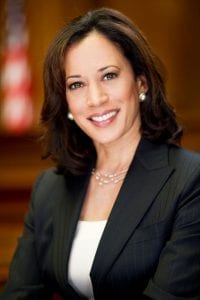
U.S. Sen. Kamala Harris is the Democratic nominee for vice president.
It was a bitter, divisive, long – decades long — and circuitous struggle.
“Men historically don’t want to give up their power,” said Laura F. Keyes, a northern Illinois librarian and actress who will give an Aug. 26 Bettendorf library presentation, at 7 p.m., on pioneering suffrage leader Elizabeth Cady Stanton. “For centuries, men have been in power, and they didn’t want to give that up. Within the suffrage movement itself, there were a lot of factions.”
Stanton fought for equal rights for women for over 50 years. Upon her death in 1902, she left behind a legacy of her crusade for female equality and myriad writings that would inspire feminists for over a century.
In 1848, she helped organize the Seneca Falls convention in New York, which called for equality between the sexes and urged women to secure the vote.
In 1854, Stanton described legal restrictions facing women during the New York State Woman’s Rights Convention in Albany. Her speech was reported in papers, printed, and presented to lawmakers in the New York State legislature. A comprehensive reform of laws regarding women passed in 1860, but by 1862, most of the reforms were repealed, according to the National Park Service.
In 1863, Stanton and Susan B. Anthony (1820-1906) created the Women’s Loyal National League, gathering 400,000 signatures on a petition to bring about immediate passage of the 13th Amendment to the U.S. Constitution to end slavery. After the 1865 end of the Civil War, the women’s movement created its first national organization, the American Equal Rights Association, to gain universal suffrage, the federal guarantee of the vote for all citizens.
Stanton’s signature headed the petition, followed by Anthony, Lucy Stone, and other leaders. But the political climate undermined their hopes. The 15th Amendment eliminated restriction of the vote due to “race, color, or previous condition of servitude” but not gender.
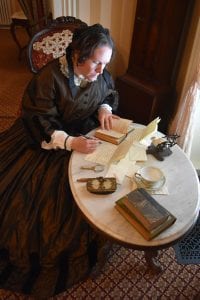
Laura F. Keyes portraying Elizabeth Cady Stanton.
1866 was a decisive year for the suffrage cause, since the 15th Amendment was being debated in Congress, and it was the start of a split in the suffrage cause, said Keyes, director of the Dunlap Public Library near Peoria.
Black men were being given the right to vote and that was a cause of frustration for people, since many women (most white) had been fighting for almost two decades for the right to vote, “and they saw that as unfair that a black man would be given the vote,” Keyes said.
“There was so much evidence during the Civil War, on both sides, that women had stepped up and helped the war effort,” she said. “It is often forgotten about. Women taught in schools; that was the start of teaching being more a female-centered profession than male. And women just ran businesses when they’re husbands went to fight; ran farms, helped with nursing.”
“The Civil War started all those shifts. People like Mrs. Stanton, Susan B. Anthony and other leaders of the cause truly thought that being given the vote would be kind of a reward for all their hard work,” Keyes said. “They were very much insulted when that was not given.”
Because of speeches Stanton gave at that time, modern critics have called her racist, she said. “They thought she was better than black men. No, she didn’t.”
“She was insulted because the government was saying she was literally not as good as a black man,” she said. “She thought they were equal. She treated people of all races as equal; she invited them to her home, sat down to dinner with them.”
The 15th Amendment granting African-American men the right to vote was adopted in 1870. Despite the amendment, by the late 1870s discriminatory practices were used to prevent blacks from exercising their right to vote, especially in the South. It wasn’t until the Voting Rights Act of 1965 that legal barriers were outlawed at the state and local levels.
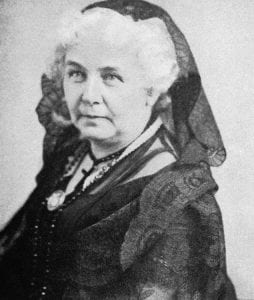
Elizabeth Cady Stanton helped organize the world’s first women’s rights convention in Seneca Falls, N.Y., in 1848, but historian Lori Ginzberg argues that Stanton wasn’t necessarily fighting for all women’s rights.
During suffrage debates, women didn’t agree on certain religious issues, Keyes said, and they fought about reformed divorce laws. There also were anti-suffrage organizations, based partly on the assumption that “politics dirty; it was morally corrupt,” she said. “Why would women want to get involved in that? And women were the ones organizing those societies, saying women shouldn’t have the right to vote.”
“She had an incredibly strong personality,” Keyes said of the imposing, well-read Stanton, also a fierce abolitionist. “She saw what needed to be changed in this world and she was incredibly brave and in a way, selfless. I admire that so much.
“She dedicated her life to this effort,” she said. “She was such a selfless person. A phrase she and Susan B. Anthony used in their letters back and forth to each other – they were not fighting for just themselves. The phrase they used was, ‘not for ourselves alone.’ They were fighting for every woman in this country.”
One of Stanton’s daughters, Harriot (1856-1940), took up the suffrage cause after her mother’s death. “Like her mother, she was a very good writer and she wrote letters to the editor; she gave the occasional speech, things like that.”
During Elizabeth’s life, “They never said white women’s suffrage, but internally in their organization, it was white women who held the offices and made the decisions,” Keyes said. “They did want universal suffrage for all women, but black women and Hispanic women were treated as secondary to white women.”
Stanton died in 1902, and by the 1890s, she had retired from being an active leader. The leaders at that time, before 1920, knew that there was a level of racism in their organization, but they didn’t address it, Keyes said. “They were dealing with all females in the nation being treated as second-class citizens.”
“Why They Marched”
On Saturday morning, the Bettendorf Public Library is hosting a virtual discussion of the 2019 book “Why They Marched: Untold Stories of the Women Who Fought for the Right to Vote,” by women’s historian Susan Ware. It will be led by Jane Simonsen, Augustana College professor of history who specializes in American’s women’s history and gender studies.
The book looks beyond the national leadership of the suffrage movement, as Ware tells the inspiring story of 19 dedicated women who carried the banner for the vote across the nation, out of the spotlight, protesting, petitioning, and demonstrating for women’s right to become full citizens.
“For too long the history of how American women won the right to vote has been told as the visionary adventures of a few iconic leaders, all white and native-born, who spearheaded a national movement,” according to a synopsis. “In this essential reconsideration, Susan Ware uncovers a much broader and more diverse history waiting to be told.”
Simonsen’s talk will start at 10 a.m. Saturday, with discussion going for 90 minutes.
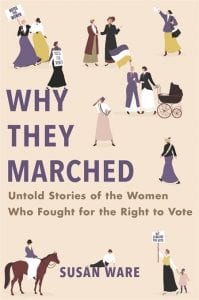
The cover of “Why They Marched.”
“I’m hoping to get some general discussion about what people know or hadn’t known about the long suffrage movement, and maybe make some connections to some political movements going on today,” she said recently.
“It kind of tells the story of suffrage and some of the divisions within the movement that some people may not know how divisive some of the strategies were, by looking at the different methods that different women used to get the word out,” Simonsen said of the book.
“And what I think is fascinating is the different reasons women got involved – African-American women, for example, had different reasons for getting involved than white women did. Women used very different methods, writing, performance, protests, the hunger strikes some of these women used late in the movement,” she said. “It really gets at the variety of strategies women used and the variety of reasons for them getting involved in the movement.”
One of the really interesting parts of the suffrage movement was “the post-Civil War era provided this moment of possibility, for the government to expand the vote to everyone,” Simonsen said.
It provided opportunities for African-American women to mobilize under the radar and do political action in places. “It divided the movement in really distressing ways,” she said. “White, elite women were upset they had been left out and black men were given the vote before white women, so that racism came to the fore and actually mobilized some Southern women and Northern women as well, to campaign harder for the vote, ‘cause they’re saying they got it and we didn’t.
“It certainly galvanized black women, because the way that African-American men, especially in the South and points north were being violently targeted when they tried to vote, made it all the more imperative for black women to say, we need this,” Simonsen said. “We need to be part of this as well.
“It was destructive to have these divisions. It was a mistake, I’m pretty confident in saying, for white women at the time to tell black women they couldn’t march.”
“African-American women did it on their own, too,” she said. “There’s some benefits to the way they were able to organize themselves that added its own strength to the movement.”
 In the Ware book, there is discussion of the anti-suffrage movement, which women were part of.
In the Ware book, there is discussion of the anti-suffrage movement, which women were part of.
“We tend of think of anti-suffrage as just men who don’t want to give rights to women,” Simonsen said. Ware profiled two sisters — one was pro-suffrage and one was anti-suffrage.
Those against wanted to see women as a protected class, not want to give up some of what they saw as women’s special status.
“Women as mothers, so some women who were anti-suffrage were thinking in terms of protecting what they thought women already had,” she said. “Even earlier anti-suffragists, just getting involved in politics in the mid-19th century, it really wasn’t an arena where respectable women wanted to show themselves. There was a lot of drinking and rabble-rousing that would go on in advance of elections.”
“There were fights that would break out; sometime shots were fired,” Simonsen said. “There were certain dangers that came with voting. For African-American women, looking at what was happening to African-American men who were voting, it must have been terrifying for them in some ways to think about the violence that they might suffer if they were to vote.”
“Voting was seen as such a masculine activity,” she said. “A woman couldn’t see herself as doing that thing, because it would seem so un-womanly in some groups.”
“Many people thought when women got the vote, they would all vote the same way, right? But of course they don’t. Men don’t vote the same way.”
After the suffrage amendment was first introduced in Congress in 1878, between January 1918 and June 1919, the House and Senate voted on the 19th Amendment five times. Each vote was extremely close and Southern Democrats continued to oppose giving women the vote.
Suffragists pressured President Woodrow Wilson to call a special session of Congress, held May 19, 1919. On May 21, 1919, the amendment passed the House 304 to 89, with 42 votes more than was necessary. On June 4, 1919, it was brought before the Senate and, after Southern Democrats abandoned a filibuster, 36 Republican Senators were joined by 20 Democrats to pass the amendment.
Was there a connection between the alcohol temperance movement and suffrage?
“That link I think is different than we might think it is, in that most women who were involved in the temperance movement were in it not necessarily ‘cause they hated beer,” Simonsen said. “They didn’t like the social effects that came with drinking and the other domestic problems that were a side effect, still are a side effect of addictions.”
“In a lot of ways, it’s a link between women involved in social reforms of all kinds, and using the vote to do that,” she said. “When Iowa had a referendum on women’s suffrage in 1916, Scott County gave it a big thumbs-down. I think the ideas that women would keep men from drinking was in some ways a little bit a scapegoat-y thing, like this is our reason for not wanting this.”

Jane Simonsen is an Augustana history professor.
“There were so many social reforms linked to the Prohibition movement, anti-vice, that to think it was just about drinking was underplaying what those reforms were about,” she said.
Prohibition (the 18th Amendment) was ratified by the states on Jan. 16, 1919 and officially went into effect Jan. 17, 1920; later repealed in 1933.
“One of the things that happens after women get suffrage – it doesn’t create the kind of giant voting bloc of women that some people feared would happen,” Simonsen said. “Women did, after getting the vote, slowly move into political positions of power. One of the big turning points for women getting higher office was when FDR took office.”
Several women in Ware’s book got their start in organizations like the League for Women Voters, labor rights groups, and got tapped by FDR to serve in his administration.
After the suffrage amendment became law Aug. 26, 1920, 26 million adult female Americans were eligible to vote. “But full electoral equality was still decades away for many women of color who counted among that number,” according to PBS.org, and “The Vote” PBS documentary, which premiered in July.
“The federal suffrage amendment prohibited discrimination on the basis of sex, but it did not address other kinds of discrimination that many American women faced: women from marginalized communities were excluded on the basis of gender and race. Native American, Asian American, Latinx and African American suffragists had to fight for their own enfranchisement long after the 19th Amendment was ratified. Only over successive years did each of those groups gain access to the ballot.”
“Liberated Voices / Changed Lives”
The Putnam Museum & Science Center in Davenport has extended its exhibit on the movement – “Liberated Voices / Changed Lives” – until Nov. 4 (the day after the presidential election). On Aug. 26 at 6:30 p.m., the 100th anniversary of the signing of the 19th Amendment, the museum will host a Zoom gathering of local women, replacing a previously planned live in-person celebration, said Rachael Mullins, Putnam president/CEO.
“We will be doing a virtual rally on Aug. 26 that invites local people from all over to join us to kind of look at the current issues facing women,” she said.
“Some of the discussion we’ve had is that ‘hard won, but still not done’ kind of approach. Though the recognition of the right to vote was an incredible milestone for women, there still are inequities, there still are challenges, and there still is a fight to continue to receive equal status.”
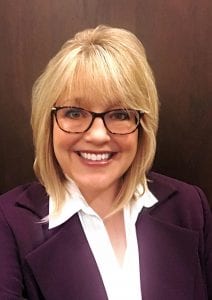
Rachael Mullins is president/CEO of the Putnam.
A series of speakers will explore a variety of issues, including women in elected office, STEM careers, poverty, race, and other local challenges. They’re also celebrating the 125th anniversary of Rock Island-based Royal Neighbors of America, which was an early innovator in supporting women’s suffrage.
“It’ll be a great celebration,” Mullins said. “There will be a series of women in various roles, addressing the modern era of women’s rights. It also is a partnership with River Music Experience, featuring live music and spoken word as well.”
The Zoom lineup of speakers Aug. 26 includes:
- Cynthia Tidwell — President & CEO, Royal Neighbors of America
- Monica Smith – Vice President of Diversity, Equity and Inclusion, Augustana College
- Chris Cournoyer — Iowa State Senator from the 49th District
- Maggie Tinsman — Former Iowa State Senator
- Spoken Word by Kiah Angelou, and music by Charlotte Boyer
The Putnam exhibit – whose major sponsor is Royal Neighbors — showcases how changing technology provided more time for women to work on the suffrage movement. The Aug. 26 online event will touch on two of the Quad-Cities women who are featured in a touch-screen exhibit on local people who worked for and against suffrage between 1900 and 1920.
The first, Myrtle Dade, was Supreme Recorder for Royal Neighbors, which was among the first women-led insurers that supported suffrage when it was founded in 1895. The company’s early members were active in supporting the suffrage movement from its initial days.
“They’re sort of our own local success story,” Mullins said of RNA. “Royal Neighbors was formed by nine women, and they really supported the suffrage movement across the nation.”
“These women were pioneers. They were heading urban households here in Rock Island and across the Midwest, away from the traditional family farms, while their husbands worked in industry,” Tidwell, RNA’s president/CEO, said recently. “They banded together to provide emotional and social support to each other during those isolating and stressful times.”
“As one of the first and largest women-led life insurers in the U.S., our pioneering heritage of standing shoulder-to-shoulder with women is as relevant today as the day we were founded in 1895,” she said. “We were not only one of the first to recognize that a woman’s life was worthy of life insurance protection, but we did so 25 years before women had won the right to vote.”

Cynthia Tidwell heads up Rock Island-based Royal Neighbors.
“Our founders also believed women’s lives had financial worth and should be eligible for the protection provided by life insurance,” Tidwell said. “To this day, we have delivered on this promise for women and their families for generations.”
“Yes, women are more than property, and our lives are worth protecting for the good of our families,” Dade says in the video produced by the Putnam, as she would have appeared in 1910.
“I manage more than 30 women in our beneficiary department, and I am not too humble to say, our efficient record management has caught the attention of other insurers asking how we accomplish our savings. I am a firm believer in perfection, and I have seen first-hand how industrious and professional women are in our workplace. Why we have brains! It’s important to use them!
“I firmly believe women will continue to make progress in the second decade of our new American century,” Dade says. “Have you heard about those women in New York? They are parading in Manhattan for better working conditions in factories and are demanding the right to vote!

Mabel Palmer was among the first female doctors of chiropractic.
“In fact, even our Royal Neighbor camps in Colorado are clamoring to support the women’s suffrage amendment. I suspect we’ll be taking up this discussion at our triennial Supreme Camp in Denver, next spring in 1911. Mark my words, we will not be silent on this issue.”
Mabel Heath Palmer (1881-1949), whose husband B.J. was president of Palmer College of Chiropractic in Davenport, was one of the first women to graduate with a Doctor of Chiropractic degree, as well as being a working wife and mother.
“Knowing the young women scholars at our school of chiropractic who are following in my footsteps, I believe that a woman can do anything a man can do,” she says in the Putnam video. “They just need to be given a chance to try. At Palmer Chiropractic, we very firmly believe this and have had women scholars working beside men almost from the beginning.
“For that matter, why are women prevented from voting or sitting on juries? Are they not citizens of this country? Because I feel this so strongly, I had ‘Equal Rights’ and ‘Votes 4 Women’ painted on all sides of the exceedingly tall smokestack on our Palmer School of Chiropractic campus.”
“I am trying to live my life to demonstrate what I feel a woman can be — intelligent, capable, a strong leader, an inspiration to men and women alike; but never to sacrifice her kindness and caring,” Palmer says.
The Putnam will also do a Bettendorf library presentation on the exhibit Sept. 17, at 1:30 p.m. Christina Kastell, Curator of History and Anthropology, will discuss how Quad-Cities women made the case for and against women’s right to vote and investigate the local roots of the women’s suffrage movement from the perspective of local women and men.
Suffrage legacy for the future
Simonsen said there’s a direct link from women’s suffrage to pursuit of the Equal Rights Amendment, which was first proposed in 1923 by Alice Paul, one of leaders of the suffrage movement.
“That was much more divisive than you might think, in that a lot of women who crusaded for the vote did not want to pass the Equal Rights Amendment because of the damage that it would do to different kinds of protected legislation, especially in the realm of workers’ rights,” Simonsen said.
“One of the ways the labor movement was trying to get more protections for workers was by saying women should be a protected class – limiting working hours, things like that. There was a lot of concern that some of the forward movement in the labor movement would be lost with the Equal Rights Amendment.
“The early history of the ERA is really interesting for understanding these further divides between different feminist groups,” Simonsen said.
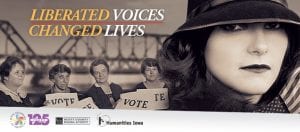
The Putnam Museum exhibit will be on display through Nov. 4.
“You see some of those divides even in the late ‘70s, early ‘80s, where you sometimes have some of the leading women’s rights advocates again saying we can’t take on race and the Equal Rights Amendment, or we can’t take on the needs of lesbian women, for example,” she said. “Some of the same divides came out in the later 20th century ERA, so we need to keep learning from these earlier errors, in thinking about what it means to move forward.”
The ERA was first passed by the House and Senate in 1972 and through 1977, 35 of the necessary 38 states ratified the amendment, but then five state legislatures revoked their approval.
“There’s still this fear that equality would be mean absolute sameness,” Simonsen said. “That was one of the real sticking points.”
Now Kamala Harris may potentially be the first female vice president (four years after Hillary Clinton won the popular vote for president). “That would be so powerful, especially given the ways the movement was so racially divided,” Simonsen said.

Ken Burns and Geoffrey Ward wrote a book about Stanton and Susan B. Anthony.
“It would be amazing if the first woman to be vice president were to be African-American and south Asian – a population you hardly see in the suffrage movement, because there weren’t that many south Asians living in the United States in 1900, 1920,” she said.
“The immigrant story, I think that would be just a great turning point for us politically and thinking about questions of citizenship and rights,” Simonsen said.
In 1916, Jeannette Rankin (R-MT) was the first woman elected to the U.S. House of Representatives. Today, there are 101 women in the 435-member House, and 26 females in the 100-member Senate. Altogether, there are 48 women of color in Congress.
“I’m happy to see a female nominated; I was happy four years ago to see a female nominated,” Keyes, the librarian, said. “I will say, we still have a long way to come. We’re not there; we still have a long way to go. There’s rampant misogyny. We have high-level elected officials insulting women publicly.”
“Not insulting their actions – these women are being verbally insulted simply because they’re women,” Keyes said. “There’s no other reason to insult them. That’s still being done constantly.”
She’s been portraying Elizabeth Cady Stanton about a year and a half, among other historic women for 12 years. “This late summer period has been very busy for me,” Keyes said, noting she’s had seven Stanton presentations this month alone, all virtual and done live allowing for Q & A.
“Even though the medium is virtual now, it still provides a sense of immediacy and after the presentation, I do enjoy engaging in a question-and-answer session with the audience, and that can only be done live.”
“I do have a theater background,” Keyes said. “I used to be very involved in community theater and used to live north of Rockford. It was in 2008 when a community theater cast me in a play as Mary Lincoln, in Freeport, Ill.”

Laura F. Keyes portraying Elizabeth Cady Stanton.
“Because I’m a librarian, I started doing research. I wanted to portray Mary Lincoln very accurately,” she said. “That led to an invitation by a number of different libraries, to come and give a talk. Wear the dress and be Mrs. Lincoln, so it snowballed from there.”
Keyes writes her own scripts, including for Laura Ingalls Wilder and Mary Todd Lincoln (wife of President Lincoln), looking for the pure truth of each. For Stanton, “I was blessed with a treasure trove of information, because she lectured widely; a lot of her correspondence has been kept, so we know what her thoughts were on many different subjects.”
Her presentation aims to be accurate and enjoyable, reflecting Stanton in an 1866 lecture on suffrage, “not just a recitation of dry facts,” she said.
“Some of Mrs. Lincoln’s presentation is more a conversation,” Keyes said. “It’s a conversation between friends.”
She gave her first virtual program in May as Stanton, and also lectures on various historical topics. “What I’m enjoying about the virtual platform is truly, people from all over the nation can take part in it. It’s wonderful. I’ve given presentations where people from coast to coast were on that call.”
Versus being in a play, Keyes enjoys the freedom to tell a detailed story as a one-woman show.
”You can focus on just one character, so that’s one thing I like about it,” she said, noting she’s co-written a conversation between Mary Lincoln and Jackie Kennedy, which Keyes does with another actress.
The Bettendorf programs are free, but registration is required at bettendorflibrary.com. The Putnam program also is free, with registration at Putnam.org.









